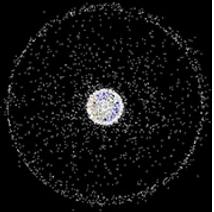
3 minute read
Celestial Clean-up: Space Sustainability, Debris and INRoS (It’s Nott Rocket Science)
By Ethan White
In the last few decades, our civilization has begun its expansion into space and its cosmic beauty. Unfortunately, the exploration of this final frontier has consequences of its own. One such issue facing the growing space industrial sector is the copious amount of waste we produce, predominantly in the form of defunct satellites and other man-made objects that have reached the end of their lifetimes. Although this may appear a trivial issue when considering the vast scope of the cosmos in its entirety as an isolated ‘blue dot’ we reside on, and specifically what’s floating around it, significant concerns are being raised within the scientific community.
Advertisement
Quantitative Analysis
NASA (2021) approximates that half a million pieces of debris the size of a marble or larger orbit Earth at speeds up to 17,500 mph This statistic is worrying regarding the damage a piece of metal travelling at such speeds can have on space craft. For comparison, a study from the Applied Acoustics Journal (2010) found that bullets of a similar diameter travel with speeds significantly slower, at 1145 ± 374 mph. Whilst space vessels are hardy in nature to withstand their environment, delicate machinery or vulnerable areas could be devastated from such collisions. This issue will remain at the forefront of developers’ minds throughout the trajectory of growth of the space industry.

Effects on Industry
A direct example of this phenomenon is the collision between Chinese military satellite Yunhai 1-02 and Object 48078, a piece of space junk from the launch rocket of a defunct Russian spy satellite launched in 1996. The vessel sustained significant damage; it is reported to have survived. It’s functionality, however, remains unknown. According to a tweet from astrophysicist and satellite tracker Jonathan McDowell, an arguably more significant result of this smash-up though is the creation of at least thirty-seven new debris instances Clearly, there is a cascading effect nestled within the heart of this problem In the absence of appropriate actions to reduce present and future debris instances over time, it will affect the sustainability of the industry exponentially.
One potential outcome is an increased emphasis on costly mitigation and reinforcement methods so space craft to survive their mission duration; slowing the development of the Space Sector. It is important to note however that not all debris has the same affect on a craft it collides with, a study from P.H.Krisko (2006) generated future growth models predicting the majority of future collisions being noncatastrophic and as between tiny pieces of debris and larger targets, however it was also noted that: “A non-catastrophic impact on an operational spacecraft could still compromise the mission.”
Problem Solving
ClearSpace is an up-and-coming player in the space industry and this company has made it their mission to combat this problem. Their first vehicle, ClearSpace-1 will launch in 20252026. Their objective is to capture larger space debris, a task originally reserved for astronauts, with robotic technology. They are clearly at the very forefront of tackling this issue and their mission raises exciting new prospects for the future of the industry as a whole.
Furthermore, The University of Nottingham’s student lead INRoS (It’s Nott Rocket Science) Team provides an example on how the younger generation of upcoming scientists are getting involved with this issue by being a part of the UKSEDs Satellite Design Competition. This project provides the structure and incentive for students across the country to design a cube-sat with the primary function of identifying and characterising space debris to help further space sustainability
INRoS’s Jason, System’s Engineer for Project Vesper said, “Space debris is becoming a big concern in the space industry. Currently, three astronauts are stranded on the International Space Station because a piece of space debris struck a cooling radiator on Soyuz, rendering it unsafe. If the space sector is going to expand this is a challenge that needs to be solved.”
Conclusion
Sustainability is often a concept that gets overlooked in the discussion of the relatively new space sector, however, it is clearly of utmost importance further demonstrated by reusing and saving of materials. The future success of technology and its continued growth is heavily intertwined with not repeating the mistakes we have made in the past as a species. If this axiom can be implemented at all levels, from the leading standards in innovation now, to new talent, the development of the sector as a whole will be much smoother whilst keeping our astronauts as safe as possible
References
NASA (2021), Space Debris and Human Spacecraft, Available at: https://www.nasa.gov/mission pages/station/news/orbital debris.html (Accessed: January 12th 2023) T.Mäkinen (2010), Shooter localization and bullet trajectory, caliber, and speed estimation based on detected firing sounds, Applied Acoustics Journal, Issue 10, page 908, Table 3, Available at: https://doi.org/10.1016/j.apacoust.2010.05.021 (Accessed January 13th 2023) J.Mcdowell (2021), Twitter, Available at: https://twitter.com/planet4589/status/1426774988812587008 (Accessed: January 13th 2023)
P.H.Krisko (2006), The predicted growth of the low-Earth orbit space debris environment – an assessment of future risk for spacecraft, SAGE Journals, Special Issue Paper 975, Page 9, Available at: 10.1243/09544100JAERO192 (Accessed: January 14th 2023) NASA Orbital Debris Program Office (2019), Available at https://orbitaldebris.jsc.nasa.gov/photo-gallery/, Graphics, (Accessed: January 14th 2023)









